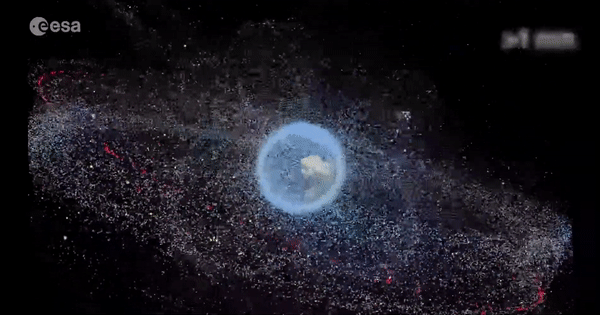Space is a messy place. An estimated 34,000 pieces of junk over 10 cm in diameter are currently orbiting Earth at around 10 times the speed of a bullet. If one of them hits a spacecraft, the damage could be disastrous.
In September, the International Space Station had to dodge an unknown piece of debris. With the volume of space trash rapidly growing, the chances of a collision are increasing.
The European Space Agency (ESA) wants to clean up some of the mess — with the help of AI. In 2025, it plans to launch the world’s first debris-removing space mission: ClearSpace-1.

The technology is being developed by Swiss startup ClearSpace, a spin-off from the Ecole Polytechnique Fédérale de Lausanne (EPFL). Their removal target is the now-obsolete Vespa Upper Part, a 100 kg payload adaptor orbiting 660 km above the Earth.
[Read: 4 ridiculously easy ways you can be more eco-friendly]
ClearSpace-1 will use an AI-powered camera to find the debris. Its robotic arms will then grab the object and drag it back to the atmosphere before burning it up.
“A central focus is to develop deep learning algorithms to reliably estimate the 6D pose (three rotations and three translations) of the target from video-sequences even though images taken in space are difficult,” said Mathieu Salzmann, an EPFL scientist spearheading the project. “They can be over- or under-exposed with many mirror-like surfaces.”
Vespa hasn’t been seen for seven years, so EPFL will use a database of synthetic images to simulate its current appearance as training material for the algorithms.
Once the mission begins, the researchers will capture real-life pictures from beyond the Earth’s atmosphere to finetune the AI system. The algorithms also need to be transferred to a dedicated hardware platform onboard the capture satellite.
“Since motion in space is well behaved, the pose estimation algorithms can fill the gaps between recognitions spaced one second apart, alleviating the computational pressure,” said Professor David Atienza, head of ESL.
“However, to ensure that they can autonomously cope with all the uncertainties in the mission, the algorithms are so complex that their implementation requires squeezing out all the performance from the platform resources.”
If the capture is successful, it could pave the way for further debris-removal missions that can make space a safer place.
Published October 30, 2020 — 17:27 UTC
October 31, 2020 at 12:27AM
https://ift.tt/37YjWxU
AI to help world’s first removal of space debris - The Next Web
https://ift.tt/2APQ0pp
/article-new/2021/06/iphone-13-duan-rui2.jpeg?lossy)
No comments:
Post a Comment